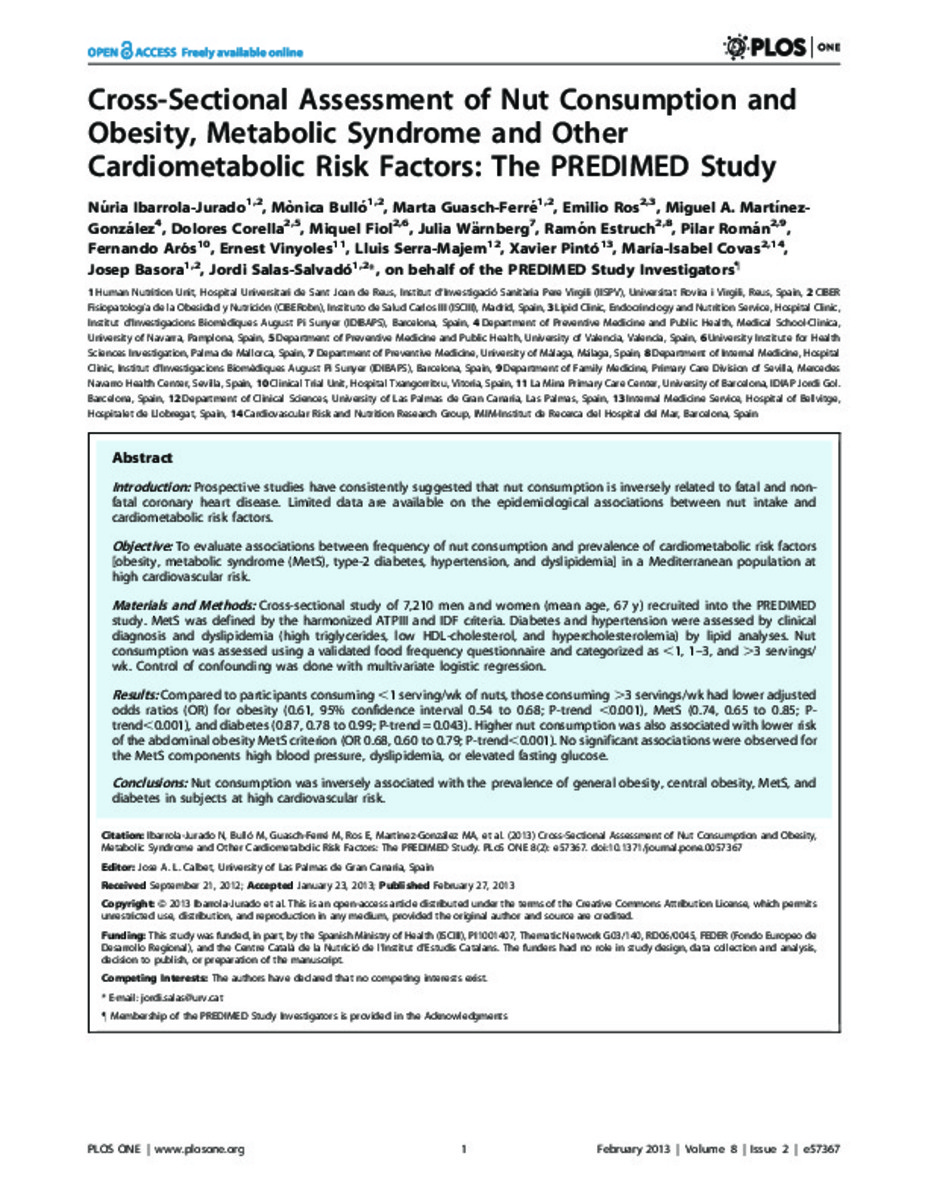Full metadata record
| DC Field | Value | Language |
|---|---|---|
| dc.creator | Ibarrola-Jurado, N. (Nuria) | - |
| dc.creator | Bullo, M. (Monica) | - |
| dc.creator | Guasch-Ferre, M. (Marta) | - |
| dc.creator | Ros, E. (Emilio) | - |
| dc.creator | Martinez-Gonzalez, M.A. (Miguel Ángel) | - |
| dc.creator | Corella, D. (Dolores) | - |
| dc.creator | Fiol, M. (Miquel) | - |
| dc.creator | Wärnberg, J. (Julia) | - |
| dc.creator | Estruch, R. (Ramón) | - |
| dc.creator | Roman, P. (Pilar) | - |
| dc.creator | Aros, F. (Fernando) | - |
| dc.creator | Vinyoles, E. (Ernest) | - |
| dc.creator | Serra-Majem, L. (Luis) | - |
| dc.creator | Pinto, X. (Xavier) | - |
| dc.creator | Covas, M.I. (María Isabel) | - |
| dc.creator | Basora, J. (Josep) | - |
| dc.creator | PREDIMED | - |
| dc.date.accessioned | 2014-10-22T11:16:14Z | - |
| dc.date.available | 2014-10-22T11:16:14Z | - |
| dc.date.issued | 2013 | - |
| dc.identifier.citation | Ibarrola-Jurado N, Bullo M, Guasch-Ferre M, Ros E, Martinez-Gonzalez MA, Corella D, et al. Cross-sectional assessment of nut consumption and obesity, metabolic syndrome and other cardiometabolic risk factors: the PREDIMED study. PLoS One 2013;8(2):e57367. | es_ES |
| dc.identifier.issn | 1932-6203 | - |
| dc.identifier.uri | https://hdl.handle.net/10171/36882 | - |
| dc.description.abstract | INTRODUCTION: Prospective studies have consistently suggested that nut consumption is inversely related to fatal and non-fatal coronary heart disease. Limited data are available on the epidemiological associations between nut intake and cardiometabolic risk factors. OBJECTIVE: To evaluate associations between frequency of nut consumption and prevalence of cardiometabolic risk factors [obesity, metabolic syndrome (MetS), type-2 diabetes, hypertension, and dyslipidemia] in a Mediterranean population at high cardiovascular risk. MATERIALS AND METHODS: Cross-sectional study of 7,210 men and women (mean age, 67 y) recruited into the PREDIMED study. MetS was defined by the harmonized ATPIII and IDF criteria. Diabetes and hypertension were assessed by clinical diagnosis and dyslipidemia (high triglycerides, low HDL-cholesterol, and hypercholesterolemia) by lipid analyses. Nut consumption was assessed using a validated food frequency questionnaire and categorized as <1, 1-3, and >3 servings/wk. Control of confounding was done with multivariate logistic regression. RESULTS: Compared to participants consuming <1 serving/wk of nuts, those consuming >3 servings/wk had lower adjusted odds ratios (OR) for obesity (0.61, 95% confidence interval 0.54 to 0.68; P-trend <0.001), MetS (0.74, 0.65 to 0.85; P-trend<0.001), and diabetes (0.87, 0.78 to 0.99; P-trend = 0.043). Higher nut consumption was also associated with lower risk of the abdominal obesity MetS criterion (OR 0.68, 0.60 to 0.79; P-trend<0.001). No significant associations were observed for the MetS components high blood pressure, dyslipidemia, or elevated fasting glucose. CONCLUSIONS: Nut consumption was inversely associated with the prevalence of general obesity, central obesity, MetS, and diabetes in subjects at high cardiovascular risk. | es_ES |
| dc.language.iso | eng | es_ES |
| dc.publisher | Public Library of Science | es_ES |
| dc.rights | info:eu-repo/semantics/openAccess | es_ES |
| dc.subject | Materias Investigacion::Ciencias de la Salud::Nutrición y dietética | es_ES |
| dc.subject | Materias Investigacion::Ciencias de la Salud::Medicina preventiva | es_ES |
| dc.subject | Nut | es_ES |
| dc.subject | Obesity | es_ES |
| dc.subject | Metabolic syndrome | es_ES |
| dc.subject | Risk factors | es_ES |
| dc.subject | Cardiovascular diseases | es_ES |
| dc.title | Cross-sectional assessment of nut consumption and obesity, metabolic syndrome and other cardiometabolic risk factors: the PREDIMED study | es_ES |
| dc.type | info:eu-repo/semantics/article | es_ES |
Files in This Item:
Statistics and impact
Items in Dadun are protected by copyright, with all rights reserved, unless otherwise indicated.






